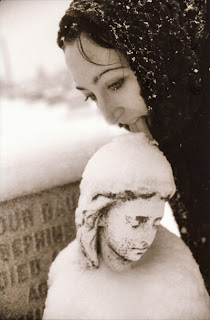 |
| Gatehouse, Mount Moriah |
Easily half of Mount Moriah’s (approximately) 380 acres were
covered by forest – an astounding sight for the uninitiated. About ten percent
of the grounds was clean-cut, as active burials were taking place there up
until 2011 (there are none allowed, at this time). The rest of the place was a
wildly overgrown thicket of invasive vines, poison oak and ivy, and thorns that could pierce through armor.
But this year is different. Thanks to the tireless efforts of a handful of individuals − leaders in the restoration effort − the progress toward freeing this beautiful cemetery from its forest confines is astounding. Looking at the photo above may give you the impression that Mount Moriah Cemetery is is mess. However, this cluster of mausoleums and monuments was buried in trees up until this past summer. You couldn't see any of this architecture before!
The Friends group has organized many official volunteer cleanup days with busloads of college students from the likes of (Philadelphia area) Cheyney and Villanova Universities, with the result being huge areas of the cemetery (both the Philadelphia and the Yeadon sides) looking neat and trim. I was rather shocked to see the condition of the Yeadon side (photo at left) in October, with the weeds all cut back and the mausoleums unobstructed by trees! Looking at this from the road, it looked like, well, a cemetery - one that you could easily enter and walk around in, safely.
 Much of the praise goes to the handful of concerned citizens
who work the cemetery not only every
weekend, but daily (many who are members of the Friends). They’ll chainsaw some trees crowding out a family plot or machete
their way to a hidden tombstone to help a visitor locate an ancestor’s grave.
Patches of tall weeds have been hacked away to provide at least visible access
to some giant monuments as well as smaller grave stones that I can only assume
have been hidden for decades. I’m not used to being able to photograph small
details (see right) on monuments and stones at Mount Moriah, but this is very possible now.
Much of the praise goes to the handful of concerned citizens
who work the cemetery not only every
weekend, but daily (many who are members of the Friends). They’ll chainsaw some trees crowding out a family plot or machete
their way to a hidden tombstone to help a visitor locate an ancestor’s grave.
Patches of tall weeds have been hacked away to provide at least visible access
to some giant monuments as well as smaller grave stones that I can only assume
have been hidden for decades. I’m not used to being able to photograph small
details (see right) on monuments and stones at Mount Moriah, but this is very possible now. |
| Circle of St. John |
 |
| Yeadon side |
 |
| Fall foliage at Mt. Moriah |
 |
| Ten-point buck at Mount Moriah Cemetery |
Further Reading:
Historic Mt. Moriah to be Brought Back from the Dead
Some wonderful genealogical reading here related to findings at Mt. Moriah.
Friends of Mount Moriah Cemetery on Facebook
If you're interested in purchasing one of the bright yellow "Friends of Mount Moriah" t-shirts depicted at the beginning of this article, please contact Friends' President Paulette Rhone. They are $16, funds which will aid the restoration effort.
To make a financial contribution to the upkeep of Mount Moriah Cemetery, click here.
Some wonderful genealogical reading here related to findings at Mt. Moriah.
Friends of Mount Moriah Cemetery on Facebook
If you're interested in purchasing one of the bright yellow "Friends of Mount Moriah" t-shirts depicted at the beginning of this article, please contact Friends' President Paulette Rhone. They are $16, funds which will aid the restoration effort.
To make a financial contribution to the upkeep of Mount Moriah Cemetery, click here.






















